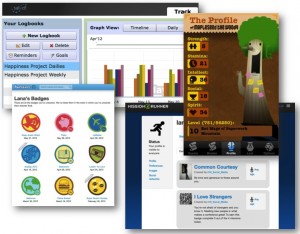Gamification–rewarding everyday behaviors with fun, points, or virtual prizes–is kind of a big deal nowadays. I’m a big proponent of gamification and I wanted to share why it works for me.
The reason I like gamification is because I invented it. I mean, you might have invented it too, but that doesn’t make my personal act of creation any less true. When I was a kid on a long errand with my parents, I would count my steps. That was the first time I ever counted to 1000. I announced it proudly to my parents and they dispensed the appropriate praise (achievement unlocked!). In school, I gamified paying attention by setting and tracking goals, such as ask or answer a question in every class for a month. In life I gamified everyday stuff, like go as long as I can without missing a day of flossing (keep the date written on my bathroom mirror). Of course, all of the points were just in my head and nobody else cared about the games that make my life just a bit more fun and just a bit less tedious.
Today, I use a number of existing tools (and tools that I have appropriated outside of their original purpose) to gamify my life:
- I check in on FourSquare when I go somewhere to get badges, mayorships, and points
- I use EpicWin to get loot and level-up a character by completing real tasks on my to-do list
- I level up my Pokemon by getting high step counts on my Pokewalker pedometer
- At CHI this year, I used MissionRunner to complete missions, get badges, and get actual prizes while getting the most out of my conference experience
- I get kudos for saving the greatest percent on groceries by posting my awesome savings on the fridge and also on SouthernSavers.com for their Friday Finals.
- I have my own set of daily and weekly goals (based on The Happiness Project book) and I track them using Salud! There’s no better reward than seeing a “perfect” day or week (though, this is closer to the way I gamified things as a child — it’s all in my head).
There are four big ways that gamification makes my life better:
- Gives me an excuse to do what I should — when the thing that I should be doing like exploring a new city, talking to a stranger, or walking 10000 steps a day feels more awkward than the thing that I’m currently doing (e.g., working in my hotel room, talking with people I already know, or sitting on the couch), sometimes the game gives me just enough of an extra push to do the right thing. It also sometimes makes a good excuse to give to others about your activity or changing activities.
- Burst of energy when close to a milestone — when I get close to the next level, the next badge, or the next round number, I get a burst of energy that helps me get there. For example, yesterday I was this close to hitting level 10 on my EpicWin character, so I actually got some of today’s todos done last night just to get that level-up feeling.
- Helps me act as the person that I want to be — this is particularly true of games where the achievements and status are shared with others in my social network. For example, I want to be the kind of person who explores new places and has fun during the week and on weekends. If when I look over the week’s checkins on foursquare all I see is “work” and “home,” I’m actually a bit more motivated to put aside the Internet and go exploring with friends, so that my checkins may actually be interesting to my friends and give off the impression that I want.
- Gives me tracking and reflection for free — most games track your progress, making self-tracking into a fun credit-getting step instead of a boring chore. I track because I like to see my progress in the game, but when I need to, I now have a treasure trove of personal data that I can review for to gain insights about myself (e.g., the longer I plan to spend working, the less I get done), to remember specific details of past events (e.g., what was that restaurant we liked on the road trip in June?), and to see potential areas to improve (e.g., Really? It’s been 5 months since my last haircut?).
So, big kudos to everybody who does this kind of work. I’d love to see more stuff out there to help me make my life even more fun. I’d love to hear about other apps, tools, and strategies that you use to make your life more fun.


